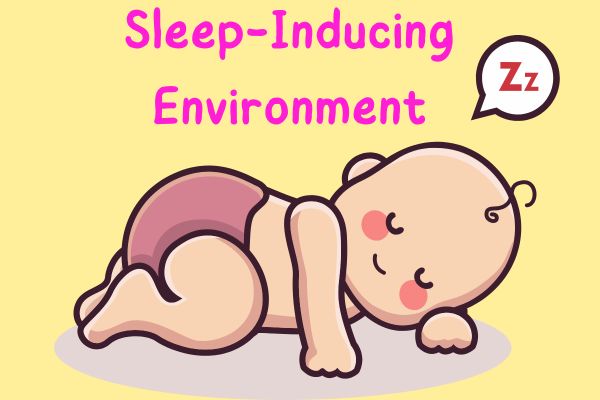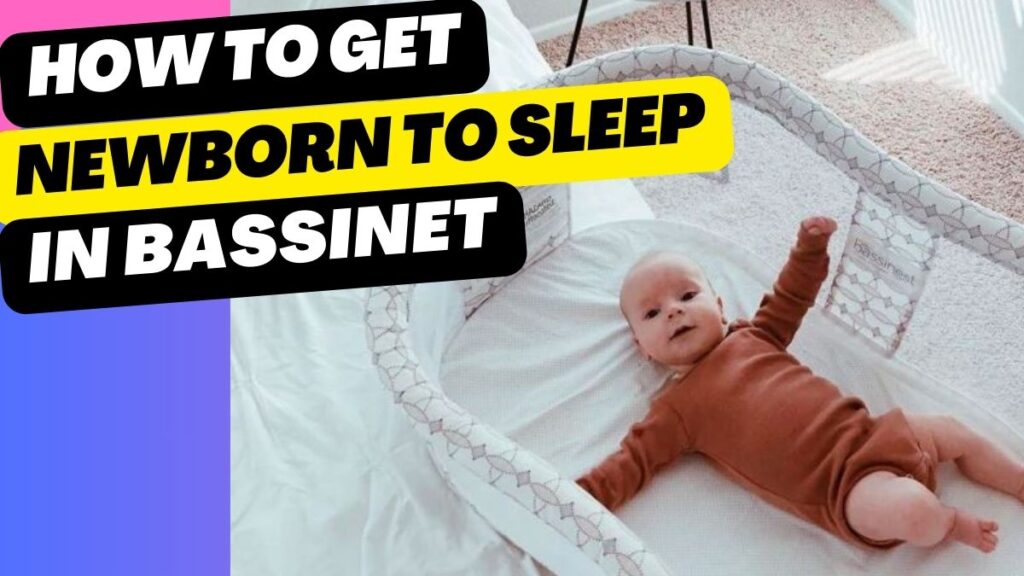How to Get Newborn to Sleep in Bassinet is one of the hardest things for a new parent to learn. You may feel overworked and tired after such short, stressful evenings. But don’t worry,However, you must remain calm and patient; we’ve got you covered! This comprehensive guide will cover everything you need to know to help your baby get comfortable in their bassinet.
If you’re struggling with how to help newborn sleep in bassinet, continue reading for practical tips and product recommendations that can make nighttime more comfortable for both you and your child.
You may want to Read: Should Newborn Daytime Naps Be in the Dark? Expert Advice”
Why It’s Hard Getting Baby to Sleep in Bassinet

Knowing why your baby won’t sleep in the bassinet is crucial before you can start using techniques to get them to sleep soundly. There are various reasons why babies frequently object to sleeping in a bassinet:
1. Comfort Issues
If a newborn is accustomed to being held or swaddled in a gentler environment, the rigidity of the bassinet may cause discomfort. Make sure the mattress in your baby’s bassinet is both strong and pleasant.
2. Gas and Reflux
Babies with reflux or gas may find it difficult to lie flat in a bassinet. To reduce any discomfort, it’s crucial to assist them with burping after eating.
3. Overstimulation or Overtiredness
It might be challenging getting baby to sleep in bassinet since they are easily stressed by lights or noise. Dimming the lights and establishing a relaxing pre-bedtime routine can have a significant impact.
4. The Need for Close Contact
It might be challenging to get many newborns to sleep freely in a bassinet since they prefer to be held. This can be worked on gradually over time and is natural.
You may want to Read: “What to Dress Baby in for Sleep: Tips for New Parents”
Step-by-Step Guide on How to Get Baby to Sleep in Bassinet
“how to get my newborn to sleep in his bassinet” this is very important question for new moms .These techniques will help you establish a calm, regular sleep schedule for your infant if you’re curious about how to get baby to sleep in bassinet.
Step 1: Create a Sleep-Inducing Environment

Create a comfortable, sleep-friendly space in your bassinet to make your baby feel safe and at ease. White noise or gentle lullabies in a calm atmosphere can ease your baby’s transition from daytime noise to bedtime.
You may want to Read: Are Baby Gowns Recommended? A Parent’s Guide to Choosing Baby Clothing
Step 2: Swaddle for Comfort

When it comes how to get your baby to sleep in bassinet, swaddling can make a big difference. By avoiding the startle reflex, a tight, breathable swaddle can help calm your baby by simulating the sensation of being carried. Choose Velcro swaddles that are simple to use, particularly when changing in the middle of the night.
You may want to Read: Should Newborns sleep in hats?
Step 3: Establish a Consistent Sleep Routine

Routine is what babies thrive on. A consistent bedtime ritual, like as bathing, feeding, swaddling, and lullaby singing, will assist your baby know when it’s time to go to sleep. When getting baby to sleep in bassinet, consistency is essential. Follow the same schedule for naps throughout the day and sleep at night.
Step 4: Lay Your Baby Down Drowsy But Awake

Putting your newborn in the bassinet when they’re sleepy but still awake is one of the most crucial ways to get them to fall asleep. Your baby will be less likely to wake up in the middle of the night if they learn how to fall asleep on their own.
Step 5: Use a Pacifier

Your infant will sleep better and be calmer if you use a pacifier. Offering a pacifier to your newborn can help them fall asleep and stay asleep longer if they have trouble falling asleep in the bassinet.
You may want to Read: Signs Baby is Too Hot While Sleeping: A Comprehensive Guide for Parents
Recommended Products for Better Sleep
These highly suggested items may help if you’re still experiencing problems getting your baby to fall asleep in the bassinet:
1. Smart Bassinets
Invest in a smart bassinet that can sense movement and gently rock your infant. These clever devices eliminate the uncertainty involved in putting your infant back to sleep.
2. White Noise Machines
A white noise machine can help your infant go asleep by blocking out background noise and establishing a dependable atmosphere. Choose one with a timer and sound volume adjustment.
3. Swaddles
A cozy, user-friendly sleep bag or swaddle blanket is essential. Your baby will feel more secure and stay asleep if you swaddle them since it lessens their startle reflex.
4. Pacifiers
When figuring out how to get a baby to sleep in a bassinet, using a pacifier can make a great impact. To lessen discomfort, look for a pacifier made specifically for newborns.
You may want to Read: Signs My Baby Is Cold at Night: How to Ensure Their Comfort
Conclusion
Learning how to get newborn to sleep in bassinet requires dedication, patience, and time. You may assist your baby get comfortable in their bassinet and have a good night’s sleep by making their surroundings conducive to sleep, setting up a bedtime ritual, and employing devices like swaddles and white noise machines. If you’re having difficulties, don’t be afraid to experiment with various methods and things that can have a significant impact on you and your child.
With these steps and a bit of persistence, getting baby to sleep in bassinet will become easier over time, giving you and your little one the rest you both need.
You may want to Read: Understanding Newborn Day-Night Confusion: A Guide for New Parents
Frequently Asked Questions About How to Get a Newborn to Sleep in a Bassinet
Q: What if my baby refuses to sleep in the bassinet?
Try starting with naps before moving on to night sleep if your baby won’t sleep in the bassinet. White noise, swaddling, and setting up a cozy space can all facilitate this process.
Q: When should I start putting my newborn in the bassinet?
As soon as you get home, you can begin placing your newborn in the bassinet. Establishing healthy sleep patterns early on is beneficial.
Q: Is it safe for newborns to sleep in a bassinet?
Yes, bassinets are made to provide a safe sleeping environment for newborns. Make sure the mattress is firm and free of any potentially dangerous pillows or loose blankets.





